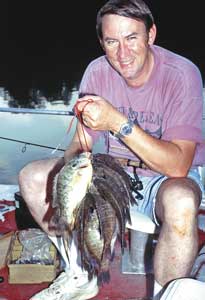
Massive shellcrackers await at Caney Lake.
If you look at Louisiana’s state records, you’ll find that anglers catch most of the big shellcrackers (chinquapin) in Caney Lake near Chatham.
What makes Caney one of the best shellcracker lakes in the nation? Louisiana outdoorsman Mike Wood knows the answer. He is also the district fisheries manager for the Louisiana Department of Wildlife and Fisheries.
“It’s not uncommon to see 2-pound shellcrackers in Caney Lake,” Wood said.
The Louisiana state-record list consists almost entirely of shellcrackers caught in Caney Lake. As with any other fish, the redear sunfish needs good habitat, an abundance of food and very little fishing mortality to grow to the older-age classes and larger sizes. Redears like wide-open spaces. They’re not cover-oriented fish.
The state impounded 5,000-acre Caney Lake, located in Jackson Parish, in 1987 to increase the recreational opportunities in the area. Caney didn’t fully fill up for 3 years, because even today plenty of rain has to fall for Caney Lake to rise. Other impoundments in this same region will have an 8-inch rise with a 1-inch rain. Caney Lake has a big watershed. Small creeks feed the lake, including Caney Creek, Smith Branch, Clear Creek, Cypress Creek and Boggy Bayou.
“I didn’t think Caney would be Louisiana’s No. 1 shellcracker lake when it was first built,” Wood said. “Shellcrackers feed differently from other sunfish. The shellcrackers actually pull up mud off the bottom into their mouths and then filter the mud back out when they expel it. They eat little invertebrates in the mud and midge fly larvae.”
Caney Lake homes a tremendous amount of midge fly larvae.
“Midge flies are bugs that resemble mosquitoes that swarm all over you at night,” he said. “You may think they’re mosquitoes, but if you notice, they don’t bite. On Caney Lake, you’ll see millions of them at dark. We do a lot of night work on Caney Lake, so when those midge flies start forming, there’ll be a ton of them all around you. You end up breathing them in and having them all over you.
“Although Caney Lake has millions of midge flies, anglers swarm in at night on Caney for the shellcrackers feeding on the larvae located on the bottom of the lake, and there are billions of the larvae. These immature midge flies look like small red worms. If you dig in the mud on Caney Lake, you’ll see large numbers of these 1/2-inch-long red worms, which is one of the shellcracker’s favorite foods.”
Shells to crack
Other lakes in Louisiana also have healthy populations of midge flies, but the Asian clams in Caney also put poundage on the shellcrackers there.
“The combination of Asian clams and the abundance of midge fly larvae produce a unique situation of an abundance of food in the habitat at Caney,” Wood said. “Anywhere you find Asian clams, you’ll find shellcrackers.
“But the problem with Asian clams is they live and create their beds on the bottom, and they’ll often be found in open water where no one can see them. Because Caney Lake has plenty of open water and Asian clam beds, there’s lots of habitat for the shellcracker. But people can’t find habitat they can’t see.
“Therefore, shellcrackers are harder to fish for at Caney than in some other lakes. For this reason, the shellcrackers here live longer and grow bigger than they do in most Louisiana lakes.
“Most anglers are structure-oriented, including myself. I like to know what I’m fishing around, like a log or a cypress tree.
“However, when you’re fishing on Caney Lake, you have to fish on wide-open water to catch shellcrackers. To make things even more complicated, the shellcrackers frequently move from place to place. When you don’t know where to fish for these shellcrackers, they have a survival advantage.”
If Caney shellcrackers live in open water and mainly stay around invisible clam beds, how does anyone ever find and catch them?
Click here to read the rest of this story, which first appeared in the February 2007 issue of Louisiana Sportsman.